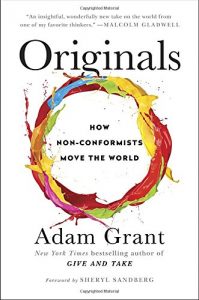“Innovation is important—it solves problems today in a way that positions us to address the unforeseen problems of tomorrow.” The Rockefeller Foundation
 Innovation, and the creativity that fuels it, drive the success of an organization in areas such as talent retention and increased revenues. As leaders, how do we foster an environment that fosters innovation? Adam Grant, an organizational psychologist and professor at the Wharton School of Business, has written a book that purports to answer that question, among others. Originals: How Non-Conformists Move the World, upends many of the preconceptions we hold about creative thinkers and innovators. From American revolutionaries to Silicon Valley entrepreneurs to Martin Luther King, Jr., Grant came to some interesting conclusions about what exactly makes an “original.”
Innovation, and the creativity that fuels it, drive the success of an organization in areas such as talent retention and increased revenues. As leaders, how do we foster an environment that fosters innovation? Adam Grant, an organizational psychologist and professor at the Wharton School of Business, has written a book that purports to answer that question, among others. Originals: How Non-Conformists Move the World, upends many of the preconceptions we hold about creative thinkers and innovators. From American revolutionaries to Silicon Valley entrepreneurs to Martin Luther King, Jr., Grant came to some interesting conclusions about what exactly makes an “original.”
What, then, is originality? Grant says that the “hallmark of originality is rejecting the default and exploring whether a better option exists.” Change agents come to the inevitable conclusion that such defaults are created by people. The realization that our fellow humans put these systems in place gives us the confidence to change or break the rules and replace it with something better.
Risk-Taking High Achievers? Perhaps Not
Achievement is highly valued in our society and even more so in business. Yet it is the drive to achieve that might stifle innovation. According to Grant, the more you value achievement, the more you come to dread failure. In our drive for the next “carrot,” we focus on guaranteed success rather than accomplishments outside the norm, ie, without praise or financial reward. Lest you think that this argument reinforces the stereotype about change agents as risk-takers looking for the latest thrill, think again.
Some of the greatest non-conformists in history were risk-averse. They were quite literally forced to respond either by circumstance or having their work “outed” by peers. The people responsible for the creation of the United States of America were often reluctant revolutionaries. John Adams only joined the cause when elected to the Continental Congress. Until then, he feared retribution by the British government. George Washington remained far from skirmishes until Adams nominated him as commander in chief of the army. These were men who clearly were not spoiling for a fight and wanted to simply go about their everyday lives. It was circumstance that forced their considerable abilities onto center stage. Original ideas, such as a republic like the one envisioned by the founders of the United States, require seismic shifts in society, ones that can be often uncomfortable and require personal sacrifice for the greater good. To create new systems, you must destroy the old ones. Human nature prefers security and the status quo.
Procrastination as Productivity
Two of the most famous speeches in history were completed at the last minute. Abraham Lincoln finished writing The Gettysburg Address the night before and finalized it the morning of. Martin Luther King, Jr. began writing the I Have a Dream speech at 10:00 p.m. the night before, and was still revising as he walked to the podium. In fact, the most famous line, “I have a dream,” was completely spontaneous.
We typically look at procrastinators as lazy or unmotivated, but Grant’s book gives evidence that some procrastination can aid in the generation of original ideas. The more time you spend with a problem or question, the longer you have to come up with a new response. Your conscious mind might be engaged in other activities, but the subconscious mind chugs along. The human brain will forget about a task once it is complete, but unfinished tasks remain active in our minds until we complete them. In the cases of King and Lincoln, those “tasks” changed the course of history.
Fostering Originality in Organizations
Applying the findings of Originals in the real world is more accessible than one might expect. In an article for the Harvard Business Review, Grant distills practical applications:
More ideas are better. People tend to come up with conventional ideas and solutions at the outset. It is at the juncture of “I’m out of ideas” that conditions are prime for innovation. “Brainstorming” sessions can stifle originality. Get people around a table and pretty soon you will see a few dominant personalities generating all the conversation and ideas. Not only does this elicit fewer ideas overall, but there is no diversity in thought. Better to have people “brainwrite” ideas before the meeting and listen to every one.
Now that you have ideas, how to evaluate them? Don’t leave it to the originator, who is too close to the situation, or even a manager, who will choose the “safe” option. Colleagues are the best critics as they are not risk averse like managers and are not personally invested in the outcome. These factors make them open to seeing new perspectives.
Dissent is crucial. As discussed above, destruction relates to creativity, and humans, fearful of change, will strive for the status quo. However, in order to innovate, there has to be some level of risk or discomfort. It may sound contrary to progress, but Grant says that making dissent an organizational value creates an environment where that status quo can be questioned and new methods proposed. Ultimately, originality as defined at the beginning of this post is a rejection of the standard in favor of a better option. As Grant himself says, “Originality is taking the road less traveled.”





